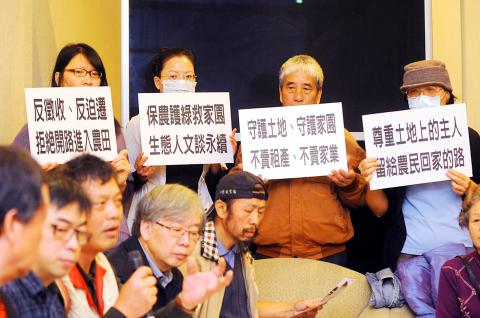Farmers from Tamsui District (淡水) in New Taipei City (新北市) yesterday protested against a town project proposed by the Construction and Planning Agency (CPA) on concerns that, in addition to forced land seizures, the project could damage the local environment.
“I live in a small house with a small plot of land attached to it. I grow vegetables on the land for my own consumption,” a local land owner in her 60s, Su Shu-yuan (蘇淑媛), said at a news conference at the legislature. “I don’t live a fancy life, but I’d say my life is good — what am I going to do if you [the government] take away my land?”
She said that, in order to keep her land, she has expressed her opposition to the land expropriation in letters to the Presidential Office, the CPA, the Control Yuan, the Ministry of the Interior and the New Taipei City Government, “but none of them seemed to really care about what I asked for.”

Photo: Wang Yi-sung, Taipei Times
“I know you are trying hard to convince us, but I am absolutely opposed to the project. Don’t even think about taking my land. I want to live the way I’ve always lived,” she added.
Su, as well as thousands of other homeowners in the area, are in a panic because the second phase of the Tamhai New Town (淡海新市鎮) project is to undergo a final review next month, and land expropriations could start as soon as the project is approved.
The Tamhai New Town project is an urban planning project first proposed in 1992 to create a new town using 1,756 hectares of land — covering as many as six farming villages — north of central Tamsui to relocate 300,000 people from the overcrowded Taipei metropolitan area.
After 20 years of development, the first phase of the project has been completed on 446 hectares. However, while the first-phase area was designed for 130,000 people, only 13,000 have moved in so far.
The second phase of the project, on the other hand, covers 1,168 hectares of land — which includes 871.33 hectares of farmland that is mostly still being used for agricultural production.
Huang Jui-mao (黃瑞茂), an associate professor in Tamkang University’s Department of Agriculture, called the second phase a “lie.”
“Despite investments made in the past 20 years, the majority of housing units are still unsold, while as many as three-fourths of the land in the first phase of the new town project is still unoccupied,” he said. “How could you move on to the second phase now, especially as the surface area of the second phase is much larger than the first?”
He added that, as food shortages are becoming a global concern and food self-sufficiency is a problem in Taiwan, “why would you take over farmland on the edge of a metropolitan area for development?”
Huang Tsung-chuan (黃宗傳), a local farmer, raised doubts about traffic and environmental issues.
“Tamsui is connected to Taipei via a narrow strip. The traffic is already very bad now, how can we handle another 300,000 residents?” Huang said. “The government wants to build an elevated expressway through the mangrove forest along the Tamsui River [淡水河], but this is going to severely damage the mangrove ecosystem.”
CPA Director-General Yeh Shih-wen (葉世文), who appeared at the press conference, said he would raise residents’ concerns in the review meeting.

Trips for more than 100,000 international and domestic air travelers could be disrupted as China launches a military exercise around Taiwan today, Taiwan’s Civil Aviation Administration (CAA) said yesterday. The exercise could affect nearly 900 flights scheduled to enter the Taipei Flight Information Region (FIR) during the exercise window, it added. A notice issued by the Chinese Civil Aviation Administration showed there would be seven temporary zones around the Taiwan Strait which would be used for live-fire exercises, lasting from 8am to 6pm today. All aircraft are prohibited from entering during exercise, it says. Taipei FIR has 14 international air routes and

Taiwan lacks effective and cost-efficient armaments to intercept rockets, making the planned “T-Dome” interception system necessary, two experts said on Tuesday. The concerns were raised after China’s military fired two waves of rockets during live-fire drills around Taiwan on Tuesday, part of two-day exercises code-named “Justice Mission 2025.” The first wave involved 17 rockets launched at 9am from Pingtan in China’s Fujian Province, according to Lieutenant General Hsieh Jih-sheng (謝日升) of the Office of the Deputy Chief of the General Staff for Intelligence at the Ministry of National Defense. Those rockets landed 70 nautical miles (129.6km) northeast of Keelung without flying over Taiwan,

The Ministry of National Defense (MND) today released images of the military tracking China’s People's Liberation Army (PLA) movements during the latest round of Chinese drills around Taiwan. The PLA began "Justice Mission 2025" drills today, carrying out live-fire drills, simulated strikes on land and maritime targets, and exercises to blockade the nation's main ports. The exercises are to continue tomorrow, with the PLA announcing sea and air space restrictions for five zones around Taiwan for 10 hours starting from 8:30am. The ministry today released images showing a Chinese J-16 fighter jet tracked by a F-16V Block 20 jet and the

City buses in Taipei and New Taipei City, as well as the Taipei MRT, would on Saturday begin accepting QR code payments from five electronic payment providers, the Taipei Department of Transportation said yesterday. The new option would allow passengers to use the “transportation QR code” feature from EasyWallet, iPass Money, iCash Pay, Jkopay or PXPay Plus. Passengers should open their preferred electronic payment app, select the “transportation code” — not the regular payment code — unlock it, and scan the code at ticket readers or gates, General Planning Division Director-General Liu Kuo-chu (劉國著) said. People should move through the